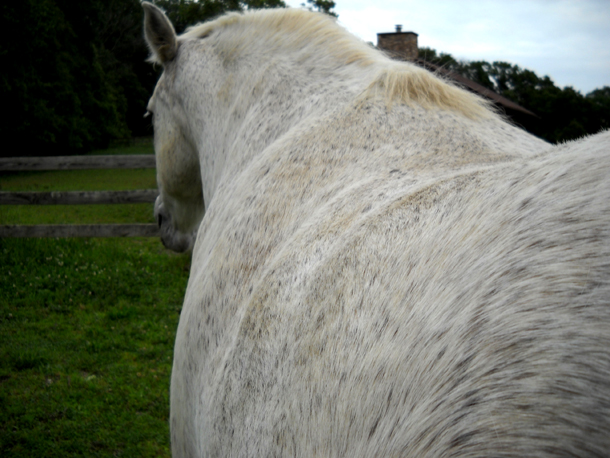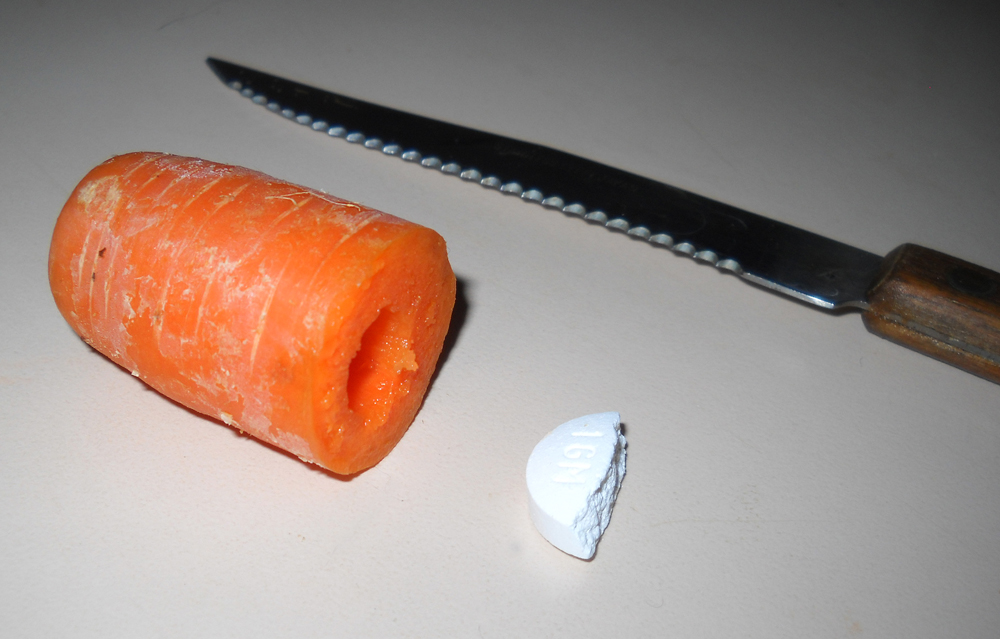Should laminitic horses get a thyroid supplement?

Kurt’s sides are lumpy despite years of taking thyroid supplements to boost his metabolism.
Editor’s note on June 15, 2015: I wrote this post before reading Juliet Getty’s post on treating the insulin resistant horse. Thyroid supplement may help the laminitic horse lose a little weight, but I think it’s a poor substitute for helping a horse restore balance in its diet and life. Even before I read Getty’s post, I had taken Kurt off thyroid powder because it was making him break out in a drenching sweat. It took me a while to figure out the cause of the sweat. The day I stopped the thyroid powder, the sweat went away. Giving thyroid powder to a laminitic horse may cause unintended consequences. I’m leaving the article up, because the reporting of the research is accurate.
Laminitic horses often are put on the thyroid supplement levothyroxine sodium (commonly sold under the brand name Thyroid-L).
While it can be an effective component for treating the insulin form of laminitis, the reasons for using it have fluctuated over the years.
The thyroid is located in the neck of all mammals. The gland secretes the hormone thyroxine, or T4, and to a lesser extent triiodothyronine, or T3. These hormones predominantly affect metabolism, but they also influence growth, development and body temperature.
The pituitary gland and hypothalamus in the brain also play a role in regulating thyroid levels. The anterior pituitary gland releases thyrotropin, a thyroid stimulating hormone referred to as TSH. The hypothalamus releases thyrotropin releasing hormone, or TRH, which affects thyrotropin.
Low thyroid levels may be the result of problems in the thyroid, hypothalamus or pituitary gland, or all three.
According to Nat Messer, DVM, at an AAEP meeting in December 1998, hypothyroidism is uncommon in horses, but widespread misdiagnosis of thyroid dysfunction results in more than $750,000 worth of thyroid hormone supplement being sold for use in horses annually.
So, why have we been using thyroid supplements for laminitic and foundered horses? There was a time when laminitic horses that were “easy keepers” were presumed to have hypothyroidism because their body condition, particularly regional fat deposits, mirrored that of dogs with hypothyroidism, plus the horses had low or low-normal resting serum T3 and T4 concentrations.
But, in a 2006 proceedings paper for the AAEP, Nicholas Frank, DVM, admitted that scientists had come to realize that low thyroid levels were a consequence rather than a cause of the horse’s metabolic issues and may even be the result of use of phenylbutazone, or bute.
That surprised me. In more than 15 years of treating laminitic horses with bute, I was never told that bute might be lowering my horses’ thyroid levels.
Still, many owners of laminitic horses, including me, have been told to try thyroid supplement because it may help speed up the horse’s metabolism so the horse can lose weight, which hopefully will lower the horse’s risk for having a relapse of laminitis. Losing weight is often a battle for foundered horses because they are too lame to exercise and their food needs drop off dramatically due to the fact that they don’t move much.
I can tell you from personal experience that Thyroid-L doesn’t always help a horse lose weight — my horses got 2 grams of Thyroid-L a day for years, and they both were obese.
Where levothyroxine sodium does appear to help is with controlling insulin levels, though insulin’s role in laminitis was only solidified by research in 2007, so Thyroid-L may have been silently doing some good on the insulin front for years while being prescribed as a weight-loss treatment.
In a study published in 2008 in the American Journal of Veterinary Research, Frank said administration of levothyroxine sodium led to weight loss and increased insulin sensitivity in adult horses with healthy thyroid gland functioning. He also said levothyroxine sodium significantly increased the rate of insulin disposal.
Note that the amount of T3 and T4 in the bloodstream regulates the release of TSH by the pituitary gland, so low levels of T3 and T4, for whatever reason, make the pituitary release more TSH. There is no shortage of studies that talk about the link between a high TSH level and insulin resistance in humans.
In a German study published in 2000 in Clinical Endocrinology, researchers concluded that study subjects with normal thyroid function (euthyroidism) but elevated TSH were more obese, had higher triglycerides and an increased likelihood for metabolic syndrome, also known as insulin resistance syndrome.
The concern with the insulin form of laminitis is how much insulin and glucose is circulating in the horse’s bloodstream. If Chris Pollitt’s Australian research team is correct, elevated insulin levels in a horse can lead to the excess insulin in the blood errantly binding with the wrong receptors in a horse’s feet (insulin-like growth factor 1 receptors, rather than insulin receptors, which don’t appear to exist in horses’ feet), leading to out-of-control hoof growth, not unlike cancer, destroying the structure of the hoof wall, coffin bone and laminae.
If Thyroid L can lead to faster disposal of insulin, that alone might be a reason to add it to the diet of the laminitic horse.
At the same AAEP meeting in 1998, Messer addressed some additional factors that may affect thyroid levels, including nutrition. He said short periods of food deprivation can lower thyroid levels, as can diet composition.
Messer and associates conducted a study at the University of Missouri (published in 1995) in which food was withheld from six adult horses with normal thyroid function for four days. Hormone levels decreased more than 50 percent over that time. When the horses returned to a normal eating schedule, their thyroid levels returned to normal.
In a laminitic horse, thyroid levels might be lowered by bute and food deprivation, which are normal treatments for laminitis, and the resulting elevated TSH levels may increase insulin resistance. Elevated insulin would cause even more damage to the feet than had happened already. Given this scenario, it’s easy to see why owners might see some improvement giving a thyroid supplement to a laminitic horse.
